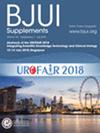小型经皮肾镜取石术中的吸痰:一项来自欧洲泌尿外科协会泌尿系统科的荟萃分析
IF 4.4
2区 医学
Q1 UROLOGY & NEPHROLOGY
引用次数: 0
摘要
目的对真空辅助输尿管鞘(VAAS)微型经皮肾镜取石术(mPCNL)与常规输尿管鞘(CAS) mPCNL的疗效进行meta分析。方法根据系统评价和meta分析首选报告项目(PRISMA)指南进行系统评价和meta分析,在PROSPERO注册(CRD42024619780)。综合检索确定了比较研究(随机对照试验和观察性研究)。主要结局包括手术时间、结石无结石率(SFR)和并发症。次要结局包括输血率、血红蛋白不足和住院时间。使用Review Manager V5.4对数据进行分析,并使用分级推荐评估、发展和评估(GRADE)工具对证据质量进行评估。结果纳入14项研究,共2510例患者(VAAS组1298例,CAS mPCNL组1212例)。VAAS mPCNL显著缩短手术时间17.45 (13.12-21.79)min (P < 0.001),并与较高的SFR相关:优势比(OR) 1.92(95%可信区间[CI] 1.57, 2.35; P < 0.001)。VAAS mPCNL组术后发热率较低(OR 0.45 [95% CI 0.35, 0.61]; P < 0.001),脓毒症发生率较低(OR 0.45 [95% CI 0.22, 0.93]; P = 0.03)。VAAS mPCNL的总并发症率显著低于CAS mPCNL (P < 0.001),轻微并发症较少。VAAS mPCNL患者住院时间较短(平均减少0.79天;P = 0.03)。输血率(OR 0.78 [95% CI 0.46, 1.31]; P = 0.3)或血红蛋白缺陷(0.00 g/dL [95% CI 0.22-0.22]; P > 0.9)无显著差异。结论VAAS mPCNL较CAS mPCNL具有手术时间短、结石清除效果好、并发症少等明显优势。这些发现支持使用VAAS mPCNL治疗肾结石,并建议进一步进行高质量的研究。本文章由计算机程序翻译,如有差异,请以英文原文为准。
Suction in mini‐percutaneous nephrolithotomy: a meta‐analysis from the European Association of Urology Section of Endourology
ObjectiveTo conduct a meta‐analysis comparing the outcomes of vacuum‐assisted access sheath (VAAS) mini‐percutaneous nephrolithotomy (mPCNL) vs conventional access sheath (CAS) mPCNL.MethodsA systematic review and meta‐analysis was conducted according to the Preferred Reporting Items for Systematic Reviews and Meta‐analyses (PRISMA) guidelines, with registration in PROSPERO (CRD42024619780). A comprehensive search identified comparative studies (randomised controlled trials and observational studies). The primary outcomes included operating time, stone‐free rate (SFR) and complications. Secondary outcomes included transfusion rates, haemoglobin deficit, and length of hospital stay. Data were analysed using Review Manager V5.4, with quality of evidence assessed using the Grading of Recommendation Assessment, Development and Evaluation (GRADE) tool.ResultsFourteen studies with 2510 patients (1298 in the VAAS and 1212 in the CAS mPCNL groups) were included. VAAS mPCNL significantly reduced operating time, by 17.45 (13.12–21.79) min (P < 0.001), and was associated with a higher SFR: odds ratio (OR) 1.92 (95% confidence interval [CI] 1.57, 2.35; P < 0.001). The VAAS mPCNL group also had a lower postoperative fever rate (OR 0.45 [95% CI 0.35, 0.61]; P < 0.001) and a lower sepsis rate (OR 0.45 [95% CI 0.22, 0.93]; P = 0.03). The overall complication rate for VAAS mPCNL was significantly lower than for CAS mPCNL (P < 0.001), with fewer minor complications. Hospital stay was shorter for VAAS mPCNL (mean reduction of 0.79 days; P = 0.03). There were no significant differences in transfusion rates (OR 0.78 [95% CI 0.46, 1.31]; P = 0.3) or haemoglobin deficit (0.00 g/dL [95% CI 0.22–0.22]; P > 0.9).ConclusionThe use of VAAS mPCNL offers significant advantages over CAS mPCNL, including shorter operating time, improved stone clearance, and reduced complications. These findings support the use of VAAS mPCNL in managing kidney stones, with further high‐quality studies recommended.
求助全文
通过发布文献求助,成功后即可免费获取论文全文。
去求助
来源期刊

BJU International
医学-泌尿学与肾脏学
CiteScore
9.10
自引率
4.40%
发文量
262
审稿时长
1 months
期刊介绍:
BJUI is one of the most highly respected medical journals in the world, with a truly international range of published papers and appeal. Every issue gives invaluable practical information in the form of original articles, reviews, comments, surgical education articles, and translational science articles in the field of urology. BJUI employs topical sections, and is in full colour, making it easier to browse or search for something specific.
 求助内容:
求助内容: 应助结果提醒方式:
应助结果提醒方式:


